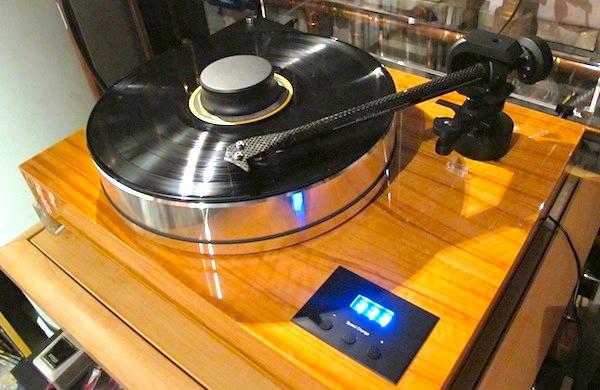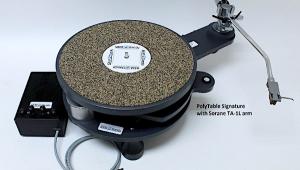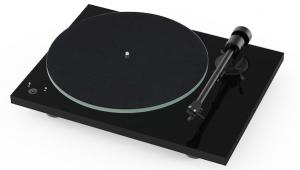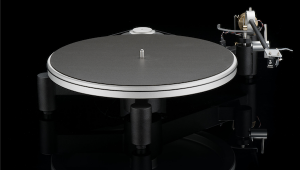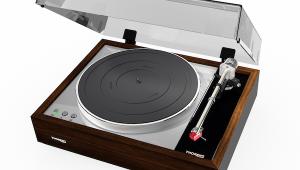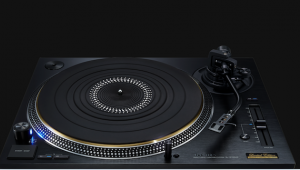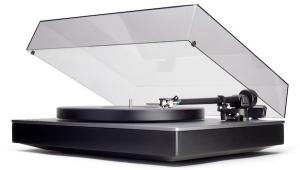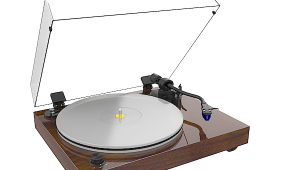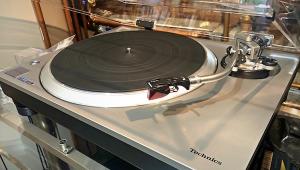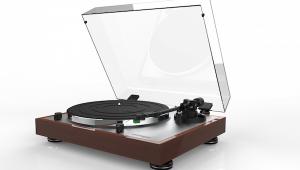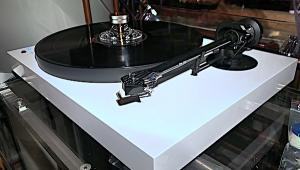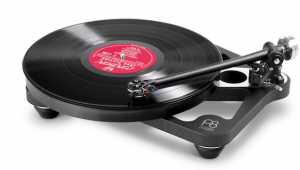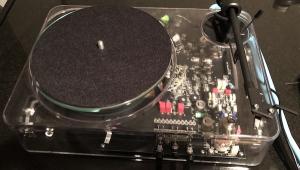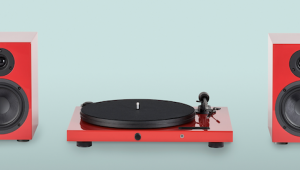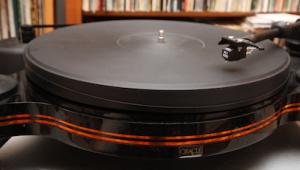Project makes a great line of tables and I can't imagine anyone being unhappy with any model they have purchased. And, a great line of phono boxes to boot. Great values. I would sure think they have sold a ton of Debut Carbons as they well should have. Hard to imagine that tonearm, cart, and table at $400...a great bargain.
The Pro-Ject Xtension10 Turntable— More Than a "Lifestyle" Product!
Success can have that effect.
Turntable Design Details
With its attractive wood-finished plinth and hinged heavy plexiglass dustcover (remember those?) the Xtension10 could be viewed as an over-achieving “lifestyle” turntable but that would be selling it way short.
The $2995 ‘table is a step down from the large, more expensive Xtension12, but that’s only if you are convinced that a 12” tonearm is better than a 10” one. I’m not. This one, at least, will fit on a standard rack shelf.
A $3699 “Superpack” option pairs the ‘table with importer Sumiko’s excellent high output moving coil Blackbird cartridge, which saves $399 over the regular $1099 price. The Blackbird has been around for a long time. How long? I reviewed it in the January 2004 issue of Stereophile! But if it ain’t broken, why fix it?
The 48 pound Xtension10 is definitely a mass-loaded design but it’s also a suspended one thanks to its four magnetically decoupled feet that do a superb job of isolating it from the outside world.
The plinth is of veneer covered MDF but judging by its considerable heft and its well-damped resonant behavior, I’d guess it’s been hollowed out and filled with sand and/or lead shot (thought that might not be legal).
The ceramic ball-topped inverted bearing is well-anchored into the plinth in its own circular sub-enclosure visible from the plinth bottom, which I suspect is where the extra weight and damping have been applied to give the plinth its surprisingly high mass.
Bonded to the 12.5 pound damped, balanced alloy platter of what is probably one of aluminum is a thick mat of well-machined recycled vinyl. The thrust pad incorporated into the platter is also of ceramic and though the product description doesn’t specify, the platter system is probably magnetically levitated to some degree.
I’m good with using mag-lev to reduce the full platter weight upon the thrust pad but dead set against a “floating” system because that produces a spring. When you rotate the platter, which you must to play a record (!) it’s going to bounce. Plus you eliminate the mechanical ground.
Drive is via an AC synchronous motor atop which is a precision dual pulley, though a built-in quartz oscillator driven electronic speed control (actually the circuitry used in the Speedbox SE that’s long been available as an “outboard” accessory) sets 33 1/3 and 45 ± a few percent in .1rpm increments. The second pulley allows you to play 78s.
The 10” EVO Carbon Fiber Arm
The arm—a variant of the separately available 10cc— of continuous carbon fiber from head shell to counterweight stub represents a high value “high tech” design in a ‘table, the total cost of which is under $3000. However, carbon fiber is not a “miracle” material. True, it is light-weight (effective mass 9 grams) and ultra-stiff but it also has a high resonant frequency that must be damped, and an arm whose mass, if too low, will not match well with low to medium compliance cartridges. But more about that later!
The ABEC7 quality bearings are set in a high mass housing giving the entire assemblage a precise, secure feel. Pro-Ject supplies three Sorbothane damped counterweights that can accommodate just about any weight cartridge.
Despite the fixed head shell, azimuth is adjustable by loosening grub screws and rotating the entire arm tube. VTA/SRA is also adjustable by loosening a pair of grub screws. Pro-Ject supplies a straight DIN to RCA cable that you can replace if you wish to try others but it’s not easily done. A Sorbothane damping sheet is the plinth/arm interface.
Set-Up
This is an easy to set up turntable. You screw into the plinth the four feet being careful to place the stiffly suspended one in the left front position where much of the weight is concentrated, place the platter on the bearing and if necessary use the feet to level the plinth. All that’s left to do then is fit the belt around the platter and pulley, affix the pulley cover plate using the three threaded chrome caps and connect the power supply. Oh, and place the dust cover onto the chromed hinge extensions.
The arm set-up is relatively straight forward. Having a gimbaled arm with azimuth adjustability at this price point is a real plus and while the VTA/SRA adjustment is coarse, at least it’s possible. You loosen the screws and the arm’s vertical shaft can be raised and lowered as desired but wherever you start you’d better make a mark of some kind on the shaft because if the sound is not to your liking, when you loosen the screws the arm will drop to its lowest position and without the reference mark you’re starting over.
Using a digital microscope and reference marks I was able to set 92 degree SRA but I’ve done it more easily! Anti-skating is the familiar weight and monofilament that loops over one of three notches in a difficult to access shaft protruding from the arm’s rear. VTF is set using the counterweight scale after leveling the arm and setting it to “0”. I have found both Pro-Ject’s VTF and anti-skating scales to be remarkably accurate but I still recommend
Using the Xtension10
The “on”/”off”, 33/45 speed choice and incremental adjustment control is located almost directly under the cartridge when the arm is at rest. It is not exactly an ergonomic delight and you have to be careful when pushing the buttons, or habituate yourself to a regimen of moving the arm above the lead-in groove before starting the platter. Not a big deal, just be careful!
You have to acclimate your fingers to how long to push the center of the three buttons. A short push starts the platter spinning at 33 1/3, but if you hold it down too long it will simultaneously start the platter and change the speed to 45. Again, this is not a big deal and just a slight learning curve.
A large fluorescent screen above the buttons tells you the chosen speed as well as the actual speed as the platter very slowly achieves the desired speed. Not a problem in my world. I don’t run a disco or radio station at home. Once it’s up to speed you can always leave the platter running. Pro-Ject also includes a high mass spindle weight.
The arm’s “vestigial” finger lift makes hand-cueing difficult. The lift is a small, slippery carbon fiber “outcropping” that’s difficult to handle. I suggest using the cueing mechanism.
Other than that, the ‘table proved trouble-free and a pleasure to use and listen to throughout the review period. It ran at precisely 33 1/3 and 45 and was easily “tweeked” to perfection or to run it a bit fast for say, when you play original pressings of Kind of Blue and Beggar’s Banquet, which were accidentally mastered at the wrong speed.
Xtension10 Sonics
This is the easy part of the review, in part because many of you have heard this ‘table on the files posted to this site for the phono preamp survey.
The Xtension10 runs at the right speed and its speed consistency is very good as the Feickert Platterspeed app demonstrates. 3150Hz is the test tone frequency and the Xtension10 can be adjusted to be right on the money. In fact, when the read out said 33.3, that was platter's measured speed. You can see on the graph that though the speed was perfect and the variations from speed were relatively minor that the pre-filtered waveform is somewhat jagged. The $175,000 Onedof turntable produced a perfect sine wave there, due in part to its superb bearing system.
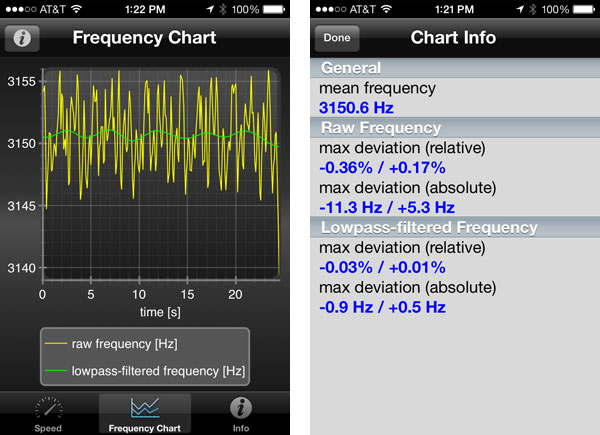
The ‘table’s low frequency performance is solid, well-extended free from overhang and the exaggerated warmth some suspended ‘tables exhibit. That’s because though the Xtension10 is suspended via its mag-lev feet, it’s also a mass-loaded design so you get sonic elements of both designs: the impactful, tight bass of a mass-loaded design and the smoothness and flow of one that’s suspended.
The ‘table exhibits excellent rhythm’n’pacing, which isn’t surprising given the bass performance but it’s enhanced by impressively clean transient performance, free of smear or softness.
In fact, if the ‘table has any easily identified sonic signature it would be a slightly over-accentuated attack and high frequency transient exaggeration.
For instance, on a great new Paul Rodgers album recorded, mixed and mastered AAA (The Royal Sessions [Pie 429 Records FTN 17972]), recorded at Willie Mitchell’s Royal Studios in Memphis, the female background singers on the opening track tend to blend into Rodgers’ vocals and mingle with the cymbals, whereas on other far more expensive rigs, they easily separate out. Rodgers’ vocals are slightly sharp too (not in pitch!). BTW: his voice is still incredible.
measured the arm/cartridge resonant frequency using the Blackbird and the Transfiguration Phoenix and both were in the desired 8-12Hz region, though right on the upper frequency borderline (11Hz), which is still fine.
The slight leading edge exaggeration means the Xtension10 would best be balanced by either a slightly soft cartridge or phono preamp, though the coloration or “personality” is so slight it might not be detectable in many systems.
I suspect that Pro-Ject’s Heinz Lichtennegger noted it. At CES 2014 he showed me a new process by which Pro-Ject will be damping future carbon fiber tonearms. Please don’t read too much into this criticism. It’s a very minor issue as anyone who listened to the Lehmann Black Cube SE II file can attest. That said, its character was not kind to the similarly but more prominently voiced PS Audio NuWave converter. I made sure to listen to that on other turntables to be sure the Xpression10 wasn’t overly exaggering the NuWave’s sonic performance (it wasn’t).
The ‘tables soundstaging abilities were very good in part because you can adjust the azimuth to maximize separation and channel balance and in equal part because of the arm’s excellent stiffness and the high quality bearings.
I thought the HO Blackbird was a great choice for the Xpresion10 but especially if you use it with a warmish phono preamp—and not necessarily one that’s tube-driven.
Despite a few small picky nits, the Xtension10 proved to be an eminently listenable reasonably priced turntable. I spent a few months listening and enjoying, especially to its black backgrounds, firm, well defined bass foundation and its expressive rhythmic drive. It’s a big ‘table with a big sound. Without seeing it you’ll know by the sound that it’s not a puny turntable.
Hell, tonearms of this build quality can cost as much as the entire package, though those who don’t like the “sound” of carbon fiber tone arms will find some ammunition here. With carefully matched associated equipment that should be a non-issue. The Xtension10’s main competition would be VPI’s $2800 Classic 1 turntable, Rega's RP8 and a few others. I am unable to make direct comparisons which is one of the inadequacies of this job. I wish that were possible. Conclusion
That said, for circa $3000 the Pro-Ject Xtension10 gives you a suspended mass-loaded turntable featuring a well-damped, attractive gloss-finished veneer plinth in a choice of three woods, a 12.5 pound alloy platter, a nicely done ceramic ball topped bearing, a built in quartz synthesized speed controller driving an A.C. synchronous motor, a 10” carbon fiber arm set in a high mass bearing housing featuring ABEC7 bearings and a dust cover. A good deal in my book.
- Log in or register to post comments


Quick question. Do you like it better than the RPM 10.1?
I'd like to see it compared to the new VPI Classic Companion TT. I am really looking forward to that review.

Is there a like button for this Turn Table. Way to go Pro Ject . This company does everything within reason and budget . See you don't have to spend 10k to a get good table.

I too would like to see a comparison with the VPI Clasic 1

Heinz has a fantastic product line, and so glad you have given this Pro-Ject Turntable a thumbs up Michael. I am pleased to tell you Pro-Ject is making my new album, Lost In Romance, and official reference disc for this product line. I am meeting up with them in Vienna in March to learn more about their company. Looking forward to more reviews from you. Kudos!

I checked my SME for speed consistency and I came up with
Raw Frequency
max deviation: -0.43% / +.42%
max deviation absolute: -13.2Hz / +13.2Hz
So the Pro-ject is beating it by a wide margin.
Have other people checked their turntables using the Feickert platterspeed App??

I've been TT shopping and came across a fantastic deal on this very turntable within the past week (in the mahogany finish). Like @djv1972 above, I was comparing the Xtension 10 to the RPM-10.1 (which seems to be its overseas designation, where it's the RM-10.1 here) and was curious about the difference. The fact that the Xtension 10 comes with the Speed Box SE built in, plus a dust cover (neither of which the RM-10.1 come with), sort of tips my decision in its favor as it is two less extras I'd have to buy.
To clarify a couple of points about construction: the base is made of MDF and is (as guessed) filled with what Pro-Ject calls a "metal sand" for dampening. The platter is a metallic alloy, damped with sorbothane on the underside, and a vinyl platter surface on top. The platter is not "floating" on magnetism, but I would say it is "assisted" so that the amount of mass riding on the ceramic ball bearing is reduced, which lowers the noise floor.
It will be neat to compare notes once mine arrives. :)

I agree with Mikey that this turntable has excellent sonics. I have it paired now with a Dynavector XX2 and it reveals a lot more information from the grooves which I've never heard before, be it analog or digital.
I had a frustrating disaster for a few months with one of the worst cartridges ever made (the Ortofon 2M Black, which was an abysmal tracker with poor sonics, not to mention extremely shoddy build quality), fussing over it for months trying to get around its many shortcomings. Thankfully the Pro-Ject arm is adjustable in all directions, but it could not do anything to redeem this steaming turd of a cartridge.
In comparison, the XX2 mounted right up. I dialed it in, threw it (not literally) under the microscope, and it's spinning perfectly with minimal fuss. I also tried the Dynavector 17D3 and while it is notoriously frustrating to align, it still eventually lined up and played quite nicely.
While the sonics are terrific, I wish I could say that about the design and build quality of this turntable, especially for the price. That aspect of it is pathetic.
1. The arm lift slowly began failing earlier this year, barely lifting off of the record. Pro-Ject wants a sickening $60+ to replace it, and they won't honor the warranty since I bought it secondhand (actually, still new in the crate at a local estate sale). Shame on them. For the price, they can certainly afford to replace an arm lifter as a goodwill gesture.
2. The dustcover can almost not be lowered before playback--it will "tick" the very edge of a record on the turntable. Dangerous, especially if a record is playing.
3. The four counterweights are cheap looking and poorly made. The dials fall off easily. They also do not grip the tonearm post all that well, and will "skip" when trying to adjust them, even with a feather touch. Worst of all, there is no clue whatsoever as to which of these weights are the heaviest or lightest--the crude instruction manual says nothing.
4. The anti-skating is far from being easy to adjust properly. This is the 21st century, and we still have to fuss with hanging a nearly invisible string on a microscopic post? To work with the Dynavector cartridges, I've had to hang a small nut on top of the weight in order to set anti-skating properly. At this price, they should throw in at least one extra counterweight, if not two or three more of different weights. A glaring oversight. Pro-Ject needs to look at the old Grace G707-II tonearm for an example of how to properly design an anti-skate mechanism. Not some Rube Goldberg contraption hanging a weight over some nearly microscopic post and hoping it's somewhere close to being right.
5. The sides of the platter are difficult if not impossible to clean. I also found a lot of post-manufacturing "grime" on it (a leftover of the machining process). Sloppy, no?
6. Finally, the speed. Yes, it is rock solid. But the controller is a flawed design. To wit:
First, turning off the turntable should be a short press, not a long press; changing speeds should be the long press. One problem is that if you long-press to turn it off, it shuts off for a fraction of a second and then starts up again.
Second, the rate at which the turntable comes up to speed for 45 RPM is painfully slow...far slower than starting at 33.3 RPM. You can watch this on the readout--the speed climbs far slowly for 45 RPM. I realize that this might have to do with 78 RPM playback, but let's be serious--how many out there are even going to use the 78 RPM speed? Most of us have dedicated setups for that. The motor and belt both have enough torque to start the turntable at a far faster rate, even for 78 RPM. There is no excuse for having to wait such a long time for the platter to come up to speed.
Finally, the controller stops at 45.1 RPM, not 45.0 RPM. So after you've waited for too long of a time to get up to speed, you have to knock it back. (And trust me, I can hear the difference in speeds--I'm cursed with that ability.)
One final comment on the speed for the suggestion box--rather than bother with the 78 RPM nonsense, why not offer a double pulley and let us run two belts as opposed to one? This tweak has worked nicely on other turntables, and I bet it would work just fine here as well.
Am I being nitpicky? Yes. But for the price of this product, I have every right to be. At this price level, things should be nearly perfect. I should not be having a failed tonearm lifter, an erratic speed controller, a dustcover that barely fits, and then to have Pro-Ject's US distributor basically give me a "tough luck" attitude any time I've contacted them...that is, when they even bothered to answer the emails, which they usually don't. (They still will not admit their speed controller is flawed, for one.)
It's a shame. Great sonics, in a beautifully finished package. I've had many compliments on both. But the small things like this are inexcusable at this price level and make it it difficult to live with. I did not like the sound of some of the other TTs I compared in the similar price range, so I felt like I was making the best choice. Apparently not.
Hope this helps anyone trying to decide if they want to purchase this turntable. Given my issues, I certainly don't recommend it, even if the sound is amazingly good (which it is).

I have been using this table for approximately one year and love it. Musical satisfaction is what this table gives you with a healthy dose of "in the room" excitement......and it looks good! Highly recommended.

The last two threads to this post are telling. One lamb bastes to the turn table, and the other adds nothing but praise. I would think that the original reviewer, who had this turn table for months would have noticed the multitude of manufacturing flaws in his sample, so something seems a bit amiss with "Rudy's" harsh criticism. I have read somewhere around a dozen reviews, and all of them offer a glowing assessment of it, with the occasional minor criticism such as the time it takes for the platter to get up to speed, and the seemingly finicky design of the counter weights. Regretfully, I have not been able to see one as none of the stores in my area that carry Project have this model in stock. This is unfortunate as I'm thinking of going for it. I'd be interested in hearing any other comments based on user's experience.

Late to this party, but hopefully assisting Jared, the last poster, and any other curious readers.
I own one of these decks. Owned 3 years, bought new, and very happy overall. I'll address some of Rudy's comments later, but first this:
Michael's comprehensive review is pretty much spot on in its content and conclusions. Remember, his system exists at the outer edges of audiophile development and price, beyond most of our imaginations, and that is the context in which he heard this TT. Choose an appropriate cart (medium to high compliance, not bright) and phono stage (nothing cold or clinical) and it will sing in even a very high end rig. This is a great value deck with nice build, great isolation and excellent speed accuracy and stability for a belt drive. The arm is fully adjustable. It does require a sturdy rack on account of its high mass and size (this ain't no Rega). Don't neglect this.
I'm not new to the TT game and did a lot of research before settling on this model. There is plenty of competition in the market right now, and what you're getting with this TT might have run $10K-plus twenty years ago. Massive machined, balanced and damped platter, carbon arm with 4 counter weights, electronic speed control, combined magnetic, spring and mass loaded isolation, excellent dust cover - you're getting a lot of machine for the money.
Is it a neutral platform? Nothing is, but it's close, and there is underlying excellence here. Michael's observation about slightly accentuated leading edge transients rings true for certain set-ups, but if your system is transparent enough to highlight this aspect you can simply tune that out with cart and phono stage choice - normal system balancing regardless of what table you choose. Many will never notice the issue, especially if amp/speakers are on the warm side of neutral. Remember many of Project's own stages are warm sounding tube designs, and this may have masked any leading edge issues during developmental listening.
To Rudy's complaints:
1. My arm lift works perfectly. No problems so far. Another Project TT I've owned for 20 years and still use weekly has a perfectly functioning arm lift, so hopefully it runs in the family.
2. Dust cover is excellent. I remove it for playback (easy), but it's one of the least "audible" lids I've used, should you play with it on. Built like a tank too.
3. Counter weights? I've had no issues, but they are oddly marked. Agree - user manual could be better. Experienced users will be fine.
4. Anti skate? Yes it's basic and fiddly, but unless you're a manic cartridge swapper you'll only use it once every few years, perhaps less if you use MM cart. Get a Technics with a 'headshell' if you wanna swap carts all the time - very quick cart changes and easy anti skate dial.
5. Yes, platter sides get finger prints. Polish it, wear the supplied gloves, or just get over it! It doesn't bother me.
6. Speed control? Yes it's slow up to speed, but it's a very heavy platter and belt drive. What do you expect? Use the time (about 12 secs) to brush your record. Otherwise, get a Technics. And 45.1 rpm is due to the 50Hz power supply in country of origin. Check your strobe discs. I'd just forget about it.
Despite all his nitpicking, Rudy did note it sounds great. And, buying from an estate sale, Rudy probably got quite the deal. I wonder, had the box been dropped to cause his lifter and lid issues?
By the way, the box itself is quite something. A massive wooden crate with great internal protection. Mine seemed lovingly packed.
Summary: great table and great value. Also other good options out there <$5K. It has its foibles; A smart buyer will understand the operational issues of heavy manual belt drive before purchase and determine if they can live with them. There are more ergonomic options, and even fully auto decks out there, if that's your bag.
Where does it stop? For me it's a keeper. I reckon it gives 90% of whatever car-priced TT you care to name, and does so for very reasonable money. Sympathetically set-up in a good system you won't be disappointed with this excellent rig.
I hope that helps any prospective purchasers.
